The age of 50 years brings to the mind a number of clichés, the foremost
of which are ‘half-a-lifetime’, ‘lessened productivity’ or ‘the dawn of
retreat.’ The other factors that come to mind are ‘the age of maturity’,
‘the voice of experience’ and ‘the peak of one’s life.’ The casual
exclusion of the former ones is surely one of the upside of being a
journal. With this issue, the Journal of Indian Academy of Pediatrics
heralds its 50th Volume. The editorial board of Indian Pediatrics
joins the Academy members, the subscribers, reviewers, and the authors,
to celebrate its Golden Jubilee and the golden years that lie ahead. To
recollect the past and acknowledge the contribution of all the 50
Presidents of Indian Academy of Pediatrics and 10 Editors of Indian
Pediatrics, we are publishing their photographs, within this
article. Let’s also have a look at what we have achieved in recent
years.
Circulation and Submissions
The circulation of the print version is nearing the
20,000 mark (estimated readership 1,00,000 per month) commensurate with
the increasing membership of the Academy (Fig. 1). Increase in
print order by more than 3000 in last 5 years has translated into
increasing burden of the resources for the journal (manpower, time,
money). Despite that we have been able to stick to a tight schedule to
ensure that this burden is not passed on to the members, and that they
continue to get their print copy by the third week of the month, every
month without fail. Cambridge Press, who are printing Indian
Pediatrics since 1981, deserve a special accolade; we are proud to
announce that not once in last 30 years we have missed our posting
schedule even by a day.
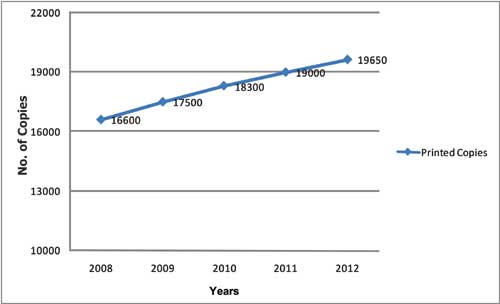 |
|
Fig. 1 Monthly circulation of Indian
Pediatrics.
|
Measures of Popularity
Increasing number of submission of manuscripts to any
journal is an objective marker of its popularity. In the last 6 years,
the submissions have increased from 750 to 1200 per annum; an increase
to the tune of more than 50% (Fig. 2). Inevitably, since the
print space is limited, the acceptance rate has decreased, but not at
the cost of rejecting good articles. In the last year, we received
submissions from 43 countries, from all inhabited continents, across the
globe.
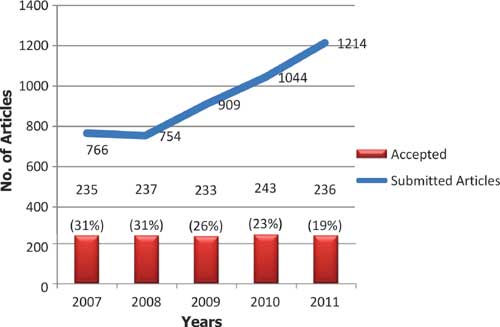 |
|
Fig. 2 Manuscripts submitted & accepted
in Indian Pediatrics.
|
Impact factor of any journal is supposed to be
another yardstick to measure its popularity [1]. Our first Impact factor
released in 2008 was 0.75. This has increased to 1.048 in 2012; an
unparalleled growth of more than 40% in last 4 years. Among specialty
biomedical journals, we are No. 1 in India. Indian Pediatrics
enjoys an incredible web presence with its website www.indianpediatrics.net
receiving over 1 million hits per month (Fig. 3). The website
is rated as the topmost ranking Pediatric journal website in the world!
To top it all, the journal is now accessed by more than 2700
institutions worldwide.
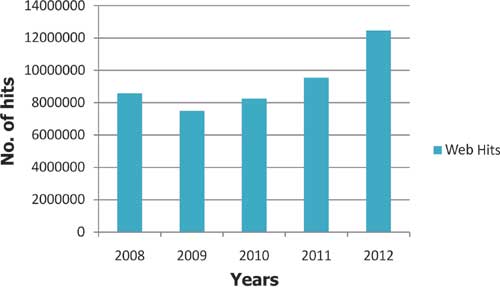 |
|
Fig. 3 Number of websites hits per
month on www.indianpediatrics.net.
|
We have completed digitization of all past issues
dating back to 1991 with in-house expertise only. Each and every article
published since 1991 is now available freely at our website. Our major
endeavor in this Golden Jubilee Year is to put up the Table of contents
of archival issues (1964 onwards) online. The process has already
started with the first ten volumes already available on our website.
| President's of IAP |
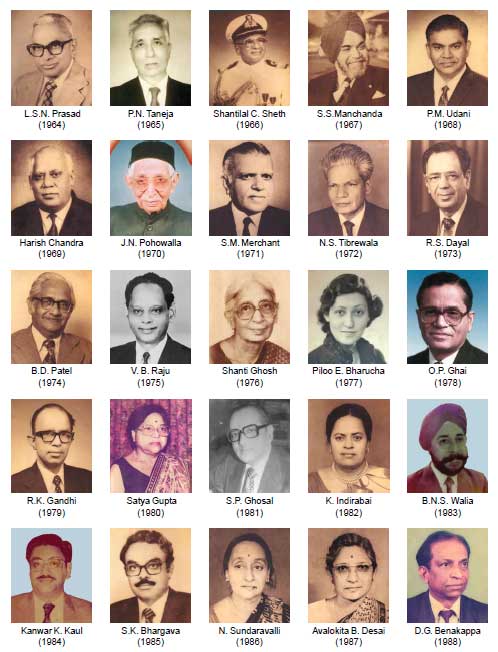 |
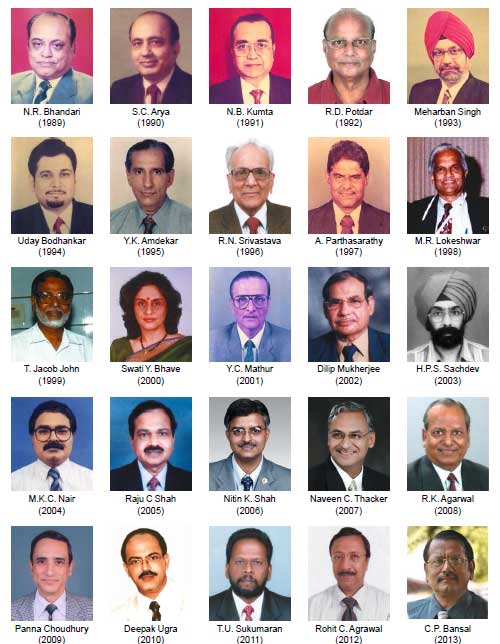 |
We are proud to say that we have kept our promises
[2] made to both our readers and the authors, without letting the
personal, financial, or other relationships affect our decisions or
losing at any time the dignity of editorial independence.
Collaboration with Springer and Online Manuscript
Management System
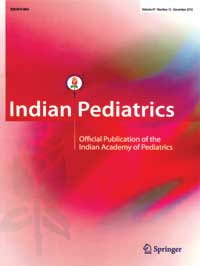 The international edition of Indian Pediatrics
(for overseas distribution) was launched in January 2010. On 19th May
2010, the online manuscript submission, tracking and peer review system
"Editorial Manager" was successfully initiated at
https://www.editorialmanager. com/inpe/. The International Edition
and Editorial Manager are the result of a unique collaboration with
Springer, a global scientific, technical and medical publisher. Springer
also hosts Indian Pediatrics on its website and has the exclusive
rights to distribute the International edition. However, unlike its
contemporaries, the journal continues to host its contents on its
website and the open access status of the journal is maintained for
authors and readers who can access the journal through
www.indianpediatrics.net, which remains fully functional as before
with the added link for online submission. Indian Pediatrics can
also be accessed through Springer webpage by clicking on to www.
springer.com/medicine/pediatrics/journal/13312 [3].
The international edition of Indian Pediatrics
(for overseas distribution) was launched in January 2010. On 19th May
2010, the online manuscript submission, tracking and peer review system
"Editorial Manager" was successfully initiated at
https://www.editorialmanager. com/inpe/. The International Edition
and Editorial Manager are the result of a unique collaboration with
Springer, a global scientific, technical and medical publisher. Springer
also hosts Indian Pediatrics on its website and has the exclusive
rights to distribute the International edition. However, unlike its
contemporaries, the journal continues to host its contents on its
website and the open access status of the journal is maintained for
authors and readers who can access the journal through
www.indianpediatrics.net, which remains fully functional as before
with the added link for online submission. Indian Pediatrics can
also be accessed through Springer webpage by clicking on to www.
springer.com/medicine/pediatrics/journal/13312 [3].
As of now, Indian Pediatrics has gone totally
online with all of the manuscripts being received, peer-reviewed and
processed through the online manuscript management system. The reviewer
base has also widened with the journal now having reviewers from more
than 40 countries. The online manuscript management system has enabled
faster review times and transparency of workflow, such as the ability to
keep track of the manuscript. In the year 2011, average turnaround time
for decision (number of days between the date the manuscript was
received and the first decision) was only 10.2 days!
To maintain the highest standards of publication
ethics besides quality publication, Indian Pediatrics is now also
screening the manuscripts for any plagiarized material with software
ithenticate, acquired with Springer collaboration.
E-Publishing
Authors had to wait for 9-12 months before a
Research paper or Short communication could be published in
Indian Pediatrics, from the date of acceptance; because of heavy
backlog due to increased quantum of submissions and limited printing
space. To obviate this problem, Indian Pediatrics started to
electronically publish all accepted articles much before the print
version (E-pub ahead of print), and also provide an immediate link to
PubMed. The paper is thus available in public domain and to the
scientific fraternity almost as soon as it is accepted.
Supplement, Special Issues and Books
Indian Pediatrics brought out a supplement issue
on "Child Development" in January 2009, based on the work done at Child
Development Centre, Thiruvananthapuram, Kerala. UNICEF supported two
Special Issues on (a) Immunization with Special Focus on Measles
(2009) and (b) severe acute malnutrition (2010). MCH-Star, USAID
and INCLEN supported release of another special issue on "ARI and
Tuberculosis" (January 2010). Another feather in the cap of Indian
Pediatrics was the publication of all guidelines and recommendations
formulated by the Indian Academy of Pediatrics (IAP), its Chapters,
Groups, and Committees; and other National bodies, in the form of a book
entitled "Editors choice: The Best of Indian Pediatrics for the
Practitioners," released in 2009. The entire print order was sold in 2
years. We also released the 3rd edition of Textbook on Pediatric and
Neonatal Emergencies in December 2010, a much sought after publication
by both practitioners and students of Pediatrics [4].
Workshops on Art and Science of Paper Writing

